Since ancient times, the Korean people have maintained a belief that food and medicine have the same origin and hence perform the same function, following the adage that 'food is the best medicine'. They believe that health and illness alike come from the food they consume and how they eat it, and this idea has played a crucial role in the development of traditional Korean medicine whose basic principle is that we should use medicine only after food has failed.
Fermentation of Food
One of the key words to understanding traditional Korean food is fermentation, a metabolic process that helps food to 'mature' so that it has improved taste and nutritional properties and can be stored for a longer period. The Korean foods that best represent the tradition of fermentation developed in Korea include doenjang (soybean paste), ganjang (soy sauce), Gochujang (chili paste) and jeotgal (salted seafood), whose fermentation can take anywhere from several months to several years. The degree of fermentation is a key factor in the taste and flavor of food cooked at home and in restaurants
Doenjang (Soybean Paste) and Ganjang (Soy Sauce)
Two of the most important items of traditional fermented food in Korea are doenjang and ganjang. To make them, it is necessary to soak soybeans in water and boil them until fully cooked. Then, they must be pounded and ormed into brick-shaped lumps, and left to dry and ferment. Then, they are placed in salted water in a large pot along with dried red chili and heated charcoal, which help remove impurities and odor during the fermentation process. The beans thus prepared are then left for about two to three months until they become fully fermented. This product should then be divided into two, solids and liquid, of which the former needs to be brewed for over five more months and the latter for over three months to develop a full flavor and taste. Just like wine, soy sauce tends to have a richer flavor and taste when brewed for a longer period.
Gochujang (Chili Paste)
Gochujang (chili paste) is a traditional Korean condiment made by fermenting a mixture of soybean malt, salt, and chili pepper powder with a blend of powdered rice, barley, flour, and malted barley. Gochujang has long been one of the most important traditional condiments among Korean people, whose palates have evolved towards a preference for hot and spicy foods since they were introduced to chili several hundred years ago. Chili and gochujang are now often regarded as a symbol of the vibrant, energetic disposition of Korean people.
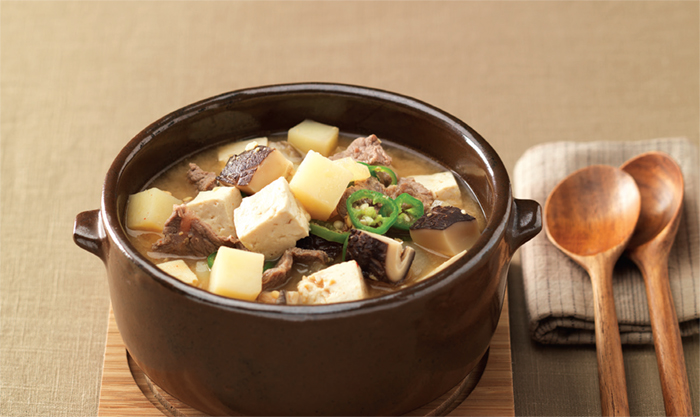
Doenjang Jjigae (Soybean Paste Stew). This stew-like Korean dish is made by boiling an assortment of ingredients such as meat, clams, vegetables, mushrooms, chili, tofu, and soy paste.

Jangdokdae (Soy Jar Terrace). An area outside the kitchen used to store large brown-glazed pottery jars containing soy paste, soy sauce, and chili paste. Korean pottery jars allow for proper ventilation, so they are perfect for preserving fermented food. The ideal location for Jangdokdae would be an area with sufficient sunlight and ventilation.
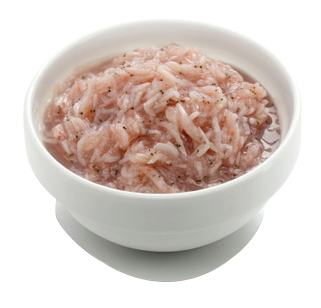
Saeujeot (Salted Shrimp). One of the two most popular fish sauces in Korea, the other being anchovy sauce, this shrimp sauce made by fermenting salted shrimps is used to improve the taste of dishes, including kimchi.
Jeotgal (Salted Seafood)
An almost indispensable ingredient for kimchi and a very popular condiment used to enhance the taste of food, jeotgal (salted seafood) is made by mixing one of a variety of seafood (such as anchovy, shrimp, oyster, or clam) with salt, or with other condiments in addition to salt, and fermenting it in a cool place. They say that a longer period of fermentation makes it tastier. The tradition of making fermented fish sauce yielded several special delicacies including sikhae, which is made by fermenting fish mixed with rice and condiments.
Kimchi
Now beginning to gain a worldwide reputation as a representative food of Korea, kimchi has been praised for its anti-carcinogenic properties and nutritional value, as well as numerous variations that create excitingly diverse flavors and tastes. The most common type of kimchi is made by mixing salted white cabbage with kimchi paste made of chili powder, garlic, spring onion, Korean radish ginger, fish sauce and other ingredients like fresh seafood. Kimchi can be eaten fresh but is normally consumed after fermenting it for several days. Kimchi is normally eaten after fermenting it for several days although some prefer called mugeunji, (ripe kimchi) which is fully fermented for over one year.
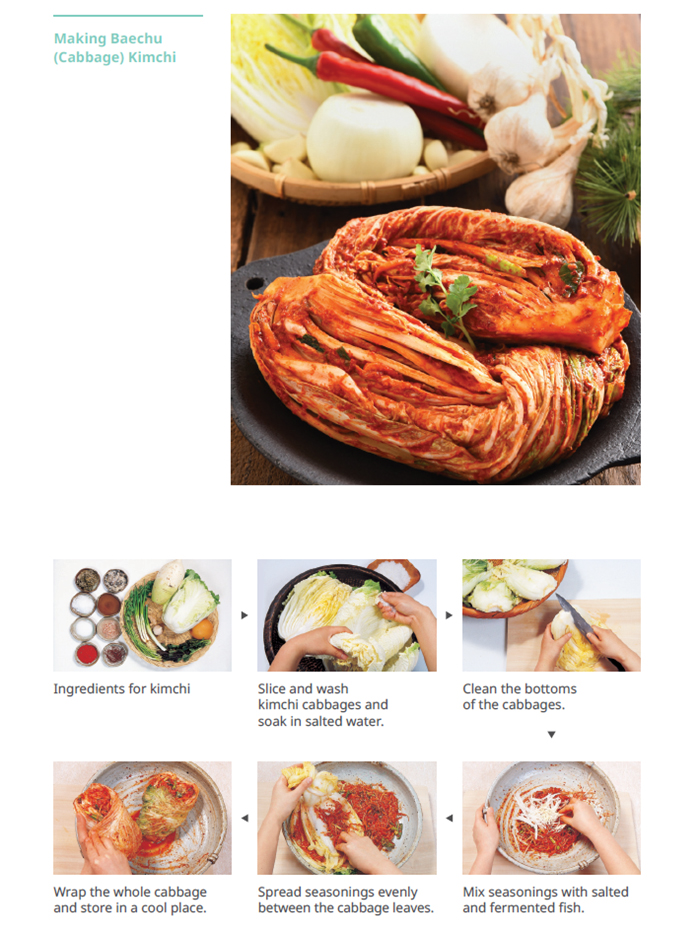
The ingredients of kimchi vary according to each region and its special local produce and traditions. Seoul, for instance, is famous for gungjung kimchi (royal kimchi), bossam kimchi (wrapped kimchi), chonggak kimchi (whole radish kimchi), and kkakdugi (cubed radish kimchi), while Jeolla-do Province is well known for its godeulppaegi kimchi (Korean lettuce kimchi) and gat kimchi (leaf mustard kimchi).
In 2001, the Codex Alimentarius Commission listed Korean kimchi in the internationally recognized standards, and in 2012 officially recognized the term "kimchi cabbage," which had previously been referred to as "Chinese cabbage" until then. In 2006, a US health magazine, Health Magazine, selected kimchi as one of the five healthiest foods on earth.
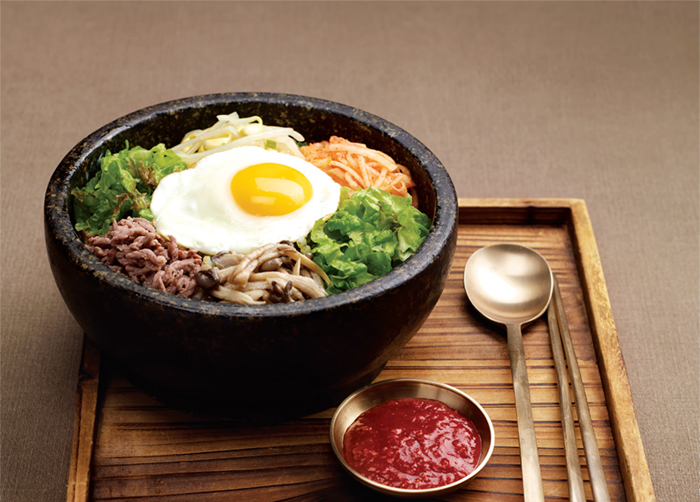
Bibimbap. Cooked rice served with fresh and seasoned vegetables, minced beef and chili paste.
Bibimbap
Bibimbap (literally “mixed rice”) is essentially a dish of cooked rice served after mixing it with an assortment of fresh and seasoned vegetables, fried egg, minced beef and other ingredients before cooking. The dish is closely related with Jeonju, a UNESCO-designated "City of Gastronomy," where food-related festivals, including the Bibimbap Festival, are held every autumn, attracting gastronomes from across Korea and beyond. Bibimbap has recently begun to attract worldwide attention for its nutritional balance, which is said to help keep those who eat it free from geriatric diseases, and is now generally cited as one of the three most representative dishes of Korean cuisine along with kimchi and bulgogi.
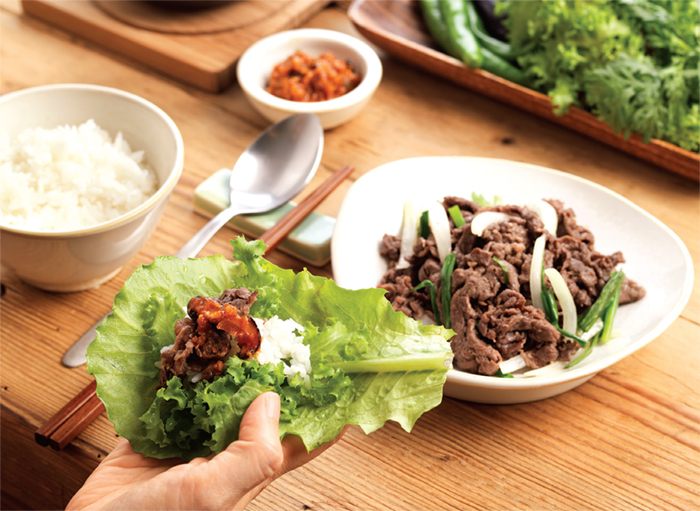
Bulgogi. Stripped or shredded beef marinated with soy sauce-based condiments and grilled.
Bulgogi
Bulgogi, which literally means “fire meat”, refers to a traditional Korean dish made by grilling beef or (rarely) pork after shredding or slicing it and marinating it in sweet soy sauce mixed with a great variety of condiments. It is one of the rare meat dishes to have developed in Korea, where people were generally more accustomed to eating vegetable dishes, and has won many enthusiasts outside the country. Bulgogi has recently been adopted by fast-food restaurants in Korea, resulting in the emergence of bulgogi hamburgers and pizzas.
Tteok (Rice Cake)
Tteok, or Korean rice cake, refers to a range of sticky cakes made by steaming powdered rice with other grains, usually beans, or by pounding boiled rice into different shapes and textures. While tteok was sometimes eaten as part of a meal, it was more often one of a variety of special foods served at special family or communal occasions such as birthday parties, wedding receptions, memorial services and traditional holidays. Rice is the main ingredient of tteok, but it is often mixed with other grains, fruits, nuts and herbs such as mugwort, red bean, jujube, soybean and chestnut.
Korean people in the past assigned various symbolic meanings to tteok and made and ate it according to those meanings. They made (and still make) baekseolgi (white steamed rice cakes), for instance, on the first birthday of a baby as it symbolizes a long life, and they made patsirutteok (steamed red bean and rice cake) whenever they started a business as its red color was believed to help repel evil forces. They celebrate New Year's Day with tteokguk, consisting of a broth with rice flakes, and Chuseok (the 15th Day of the Eighth Lunar Month) with songpyeon, bite-sized half-moon shaped rice cakes stuffed with a honey, chestnut, soybean, or sesame mixture. There are many famous tteok houses in Nagwon-dong in downtown Seoul.
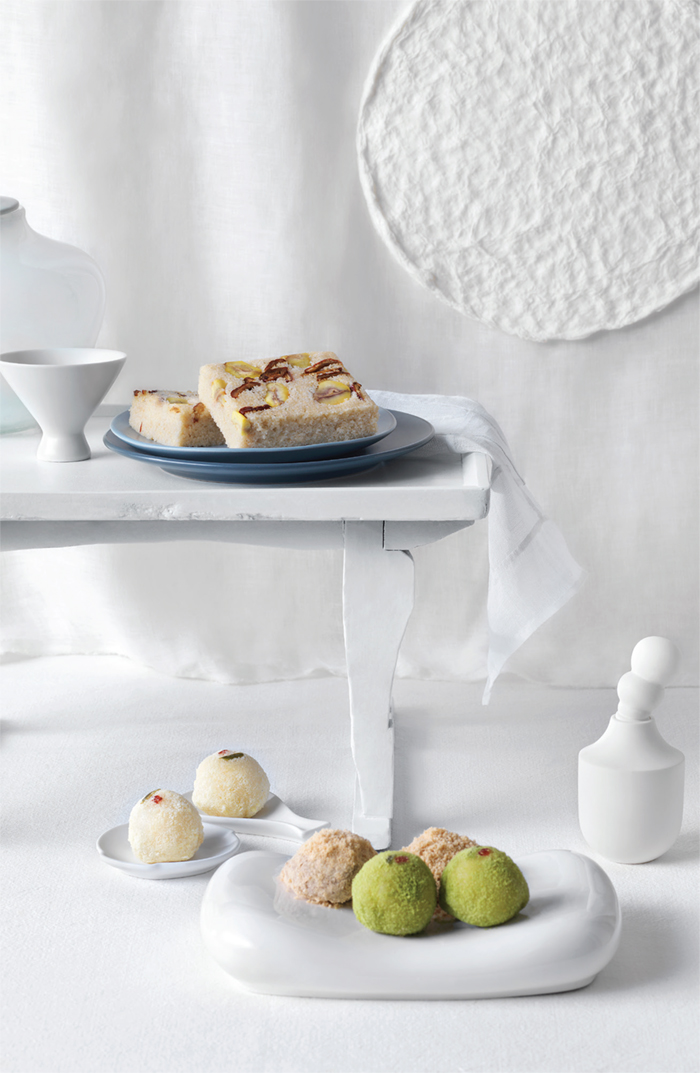
Gyeongdan. Gyeongdan is a type of small rice cake made by kneading glutinous rice powder with hot water, shaping the dough into balls, boiling them in hot water, and coating them with a powder such as bean or sesame seed powder. These days, sponge cake crumbs are also used to coat gyeongdan.
Juk (Porridge)
Juk is a Korean-style porridge made of various grains that is usually served to children, the elderly, or people suffering from digestive problems. In recent years juk houses have begun to appear in many parts of Korea. They usually prepare the dish with a wide range of ingredients, mostly grains and vegetables, and it has also been developed into numerous varieties, some of which are now served at small specialty diners.
Noodles
Korean people have developed a wide range of noodle dishes that are full of symbolic meanings. One such dish is janchi guksu (literally "banquet noodles"), which is served in a hot anchovy broth to the guests at a wedding reception, (hence the name). This dish is so closely related with the idea of a happy marriage in Korea that a question such as "When can we eat noodles?" would readily be understood to mean "When do you plan to get married?" It is also eaten to celebrate birthdays because it symbolizes a long, healthy life. Korean people also have a long established tradition of eating naengmyeon (cold buckwheat noodles), served in either cold beef broth (Pyeongyang naengmyeon) or with a spicy chili sauce (Hamheung naengmyeon).
Hanjeongsik (Korean Set Menu)
Hanjeongsik, otherwise known as the Korean set meal, originally consisted of cooked rice, soup, and anywhere from three to five, (largely vegetable,) side dishes. As people are gradually becoming better off due to the thriving national economy, today's set meal tends to be much more luxurious with tens of new dishes, meat and fish included, although the three basic dishes, i.e. rice, soup, and kimchi, still remain. Two cities in the southwestern part of Korea, Jeonju and Gwangju, are particularly famous for this traditional Korean meal.
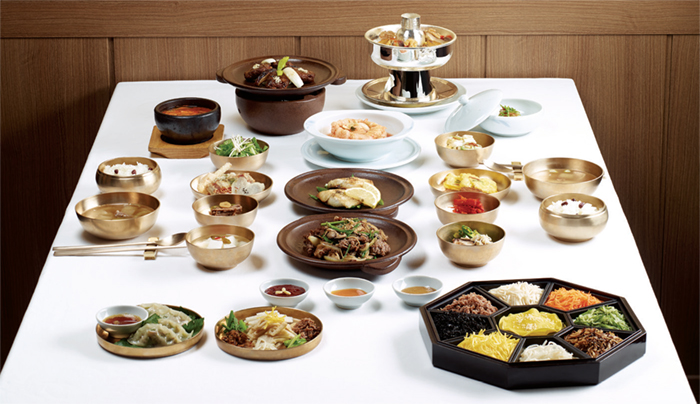
Hanjeongsik (Korean Set Menu). This traditional Korean set meal typically consisted of rice and soup and an assortment of side dishes. The meal is often divided into subgroups according to the number of side dishes, i.e. 3, 5, 7, 9 and 12.
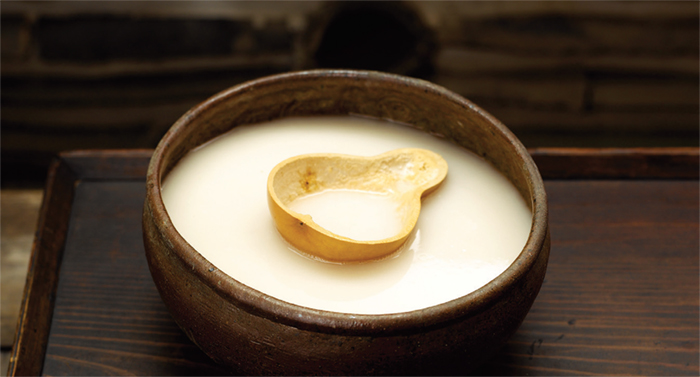
Makgeolli. This rustic alcoholic beverage, which is widely popular in Korea, is made by fermenting steamed rice, barley, or wheat mixed with malt.
Korean Temple Cuisine
Korean Buddhist temples have maintained their own culinary traditions, creating a wonderful range of vegetable dishes and ingredients and developing recipes to provide the proteins and other substances required for the monks and nuns to remain healthy. Temple foods are now enthusiastically received by vegans and other people who follow special diets for health-related reasons.
Alcoholic Beverages
A wide variety of alcoholic beverages have been developed across different parts of Korea to meet the needs of local communities during holidays, festivals, memorial rites and other commemorative occasions. Currently some 300 traditional beverages have survived, including Munbaeju (wild pear liquor) and Songjeolju (pine knot liquor) in Seoul; Sanseong Soju (distilled liquor) in Gwangju of Gyeonggi-do Province; Hongju (red liquor) and Leegangju (distilled liquor) in Jeolla-do Province; Sogokju (rice wine) in Hansan of Chungcheong-do Province; Insamju (ginseng liquor) in Geumsan; Gyodong Beopju (rice liquor) and Andong Soju (distilled liquor) in Gyeongju of Gyeongsangbuk-do Province; and Okseonju (distilled liquor) in Hongcheon of Gangwon-do Province.
One of the most popular traditional alcoholic beverages across Korea today is makgeolli (rice wine), which is also known by other names such as nongju (farmer’s wine), takju (cloudy wine) and dongdongju (rice wine). It is made by a process in which steamed rice, barley or wheat is mixed with malt and left to ferment, and has an alcohol content of 6-7%, making it a fairly mild drink. As the fermented liquor receives more recognition for its healthy aspects, it is gaining popularity among foreign tourists visiting Korea.
Another hugely popular alcoholic beverage of Korea is soju which is made by adding water and flavoring to alcohol extracted from sweet potatoes and grains. With an alcohol content that varies but is significantly higher than makgeolli, it is much appreciated by ordinary citizens across Korea and is rapidly gaining enthusiasts outside Korea.
